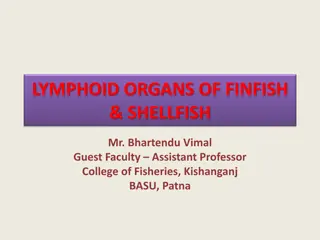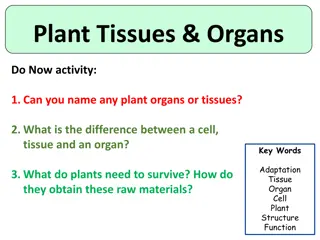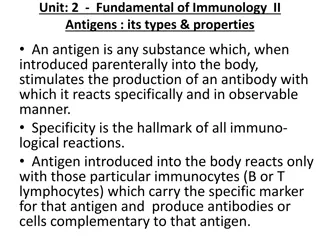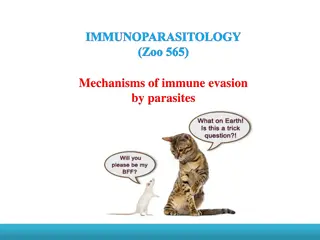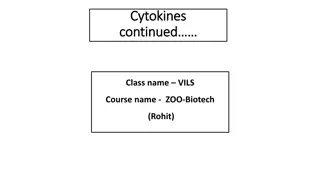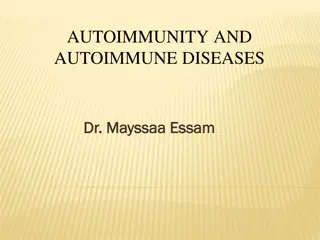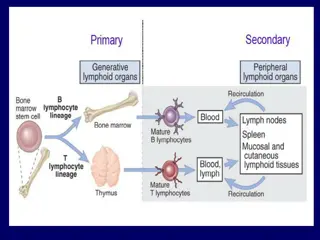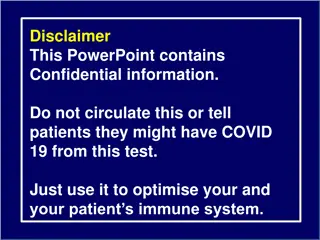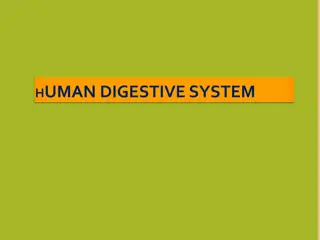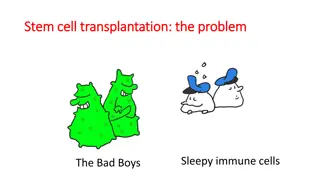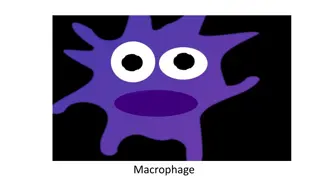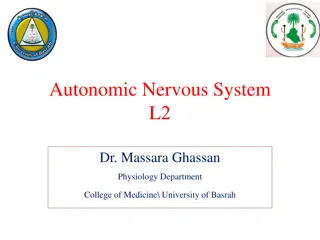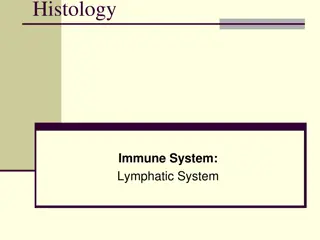Understanding the Immune System: Organs, Functions, and Importance
The immune system acts as a defense mechanism against pathogens and infections, comprising various organs, such as the bone marrow, thymus, spleen, white blood cells, antibodies, complement system, and the lymphatic system. It works to recognize and destroy harmful microbes, maintaining the body's health. The lymphatic system plays a crucial role in managing fluid levels, responding to bacteria, and absorbing fats from the diet. Primary and secondary lymphoid organs, like the bone marrow, thymus, lymph nodes, and spleen, are essential components in supporting immune functions. Abnormalities in the immune system can lead to various disorders like allergies, immunodeficiencies, and autoimmune diseases.
Download Presentation

Please find below an Image/Link to download the presentation.
The content on the website is provided AS IS for your information and personal use only. It may not be sold, licensed, or shared on other websites without obtaining consent from the author. Download presentation by click this link. If you encounter any issues during the download, it is possible that the publisher has removed the file from their server.
E N D
Presentation Transcript
Human Biology Prof. Dr. Ahmed Ali Mohammed Lecture 5 Organs & Organ Systems The Immune System
The Immune System The immune system is a barrier to the pathogens. Our immune system is made up of both individual cells and proteins as well as entire organs and organ systems that defends the body against infection. The organs of the immune system include the skin and mucous membranes, and the organs of the lymphatic system too. Normally, the immune system is composed of primary (or central) and secondary (or peripheral) organs. The immune system keeps a record of every germ (microbe) it has ever defeated so it can recognise and destroy the microbe quickly if it enters the body again. Abnormalities of the immune system can lead to allergic diseases, immunodeficiencies and autoimmune disorders.
The main parts of the immune system are: 1. Bone marrow. 2. Thymus. 3. Spleen. 4. White blood cells. 5. Antibodies. 6. Complement system. 7. Lymphatic system.
The Lymphatic system The lymphatic system is a network of delicate tubes throughout the body. The main roles of the lymphatic system are to: 1. Manage the fluid levels in the body. 2. React to bacteria. 3. Deal with cancer cells. 4. Deal with cell products that otherwise would result in disease or disorders 5. Absorb some of the fats in our diet from the intestine.
The lymphatic system is made up of: 1. Lymph nodes (also called lymph glands): which trap microbes. 2. Lymph vessels: tubes that carry the lymph, the colourless fluid that bathes the body's tissues and contains infection-fighting white blood cells. 3. Lymphocytes: which are white blood cells. 4. The Spleen 5. The Bone marrow 6. The Thymus
Lymphoid organs A- Primary lymphoid organs: These organs include the bone marrow and the thymus. The primary organs enable the performance of functions of the cell and immunoregulation. The bone marrow is a primary immune organ and the source of all cell lines used by the immune system and the place of B-cell maturation. Whereas the thymus is a primary immune organ in which thymocytes are differentiated into T cells, and a variety of immunoregulatory substances are produced. They are both create special immune system cells called lymphocytes.
B- Secondary lymphoid organs: These organs include the lymph nodes, spleen, tonsils and certain tissue in various mucous membrane layers in the body (for instance in the bowel). They are these organs where the cells of the immune system do their actual job of fighting off germs and foreign substances. The primary lymphoid organs 1. Bone marrow Bone marrow is a sponge-like tissue found inside the bones, where most immune system cells are produced and then also multiply. These cells move to other organs and tissues through the blood. The bone marrow s pluripotent stem cells can be differentiated into a variety of cell types, e.g., lymphoid stem cell.The blood vessels of the bone marrow create a blood-marrow barrier, which inhibits immature cells from leaving the bone marrow.
There are two types of bone marrow, red marrow, which is made up of hematopoietic tissue including cells of the immune system, and yellow marrow, which consists of fat cells. At birth, many bones contain red bone marrow, which actively creates immune system cells. Over the course of our life, more and more red bone marrow turns into fatty tissue. In adulthood, only a few of our bones still contain red bone marrow, including the ribs, breastbone and the pelvis. From the clinical point of view, the bone marrow is the most important object for transplantation in children with primary immunodeficiencies. Biopsies of the bone marrow widely used for diagnostic purposes in haematology.
2. Thymus The thymus is located behind the breastbone above the heart. This gland-like organ reaches full maturity only in children, and is then slowly transformed to fatty tissue. Special types of immune system cells called thymus cell lymphocytes (T cells) mature in the thymus. These cells coordinate the processes of the innate and adaptive immune systems. T cells move through the body and constantly monitor the surfaces of all cells for changes. The thymus consists of capsule-coated lobules containing the strictly isolated parenchyma, and the future T cells, thymocytes, which may pass through the vessel endothelium here. There are three parenchymal zones of the thymus: subcapsular, cortical and medullary that accord with major stages of T-cell lymphopoiesis. The thymus produces numerous hormones, neurotransmitters, and molecules of the immune system. From the clinical point of view, a thymectomy performed in adults does not lead to any immunodeficiency.
Secondary lymphoid organs 1. Lymph nodes Lymph nodes are small bean-shaped tissues found along the lymphatic vessels. They act as filters. Various immune system cells trap germs in the lymph nodes and activate the creation of special antibodies in the blood. Swollen or painful lymph nodes are a sign that the immune system is active, for example to fight an infection. Each lymph node is divided into lymph nodules, which contain a cortical zone of primary follicles with B cells, a paracortical zone of T cells, and a basal part of the nodule in the medulla. The lymph nodes are among the secondary organs of the immune system, widely present in many parts of the body, and have an artery, vein, and afferent and efferent lymphatic vessels. The afferent lymphatics are multiple and wider than efferent vessels, so, cells and molecules can easily enter the lymph nodes.
Conversely, the passage of large cells like macrophages through the efferent vessels is difficult, so that they remain to function within the lymph node. From the clinical point of view, the lymph nodes have essential clinical significance. They may be enlarged, swollen, and inflamed in many infections, tumors, and even under some non-infectious conditions. The palpation of accessible lymph nodes serves as a suitable means of monitoring for any physician. 2. Spleen The spleen is one of the secondary organs of the immune system but functions at the systemic level when antigens enter the blood. Thus, the spleen is important in fighting the infections that have invaded the blood. The spleen is located in the left upper abdomen, beneath the diaphragm, and is responsible for different kinds of jobs: it stores various immune system cells. When needed, they move through the blood to other organs.
Scavenger cells (phagocytes) in the spleen act as a filter for germs that get into the bloodstream. It breaks down old or damaged red blood cells (erythrocytes), stores and breaks down platelets (thrombocytes). It also makes disease-fighting components of the immune system (including antibodies and lymphocytes). The spleen consists of red pulp and white pulp. The red pulp plays a role in blood clearance, removing old erythrocytes, maintaining an additional reservoir of blood, and metabolizing haemoglobin. The white pulp is composed of lymphoid follicles, rich in B cells; the marginal zones rich in B cells, and periarteriolar lymphoid sheaths rich in T cells. The white pulp is vital for the immune processes including B-cell-mediated responses, synthesis of antibodies, removal of antibody-coated microbes, production of properdin, and storage of monocytes. Properdin is a protein present in the blood, involved in the body's response to certain kinds of infection.
From the clinical point of view, a splenectomy (spleen removal) leads to a significant increase in the usual death rate from pneumonia and a much diminished frequency of memory B cells. If splenectomy is planned, vaccination against Pneumococci must be performed. There is always a lot of blood flowing through the spleen tissue. At the same time this tissue is very soft. In the event of severe injury, for example in an accident, the spleen may rupture easily. Surgery is then usually necessary because otherwise there is a danger of bleeding to death. If the spleen needs to be removed completely, other immune system organs can carry out its roles.
3. Tonsils The tonsils are also secondary organs of the immune system part. Because of their location at the throat and palate, they can stop germs entering the body through the mouth or the nose. The tonsils also contain a lot of white blood cells, which are responsible for killing germs. There is also lymphatic tissue on the side of the throat, which can perform the functions of the palatine tonsils if they are removed. 4. Mucous membranes The bowel plays a central role in defending the body against germs. More than half of all the body's cells that produce antibodies are found in the bowel wall, especially in the last part of the small intestine and in the appendix. These cells detect the foreign substances, and then mark and destroy them.
They also save information about the substances in order to be able to react more quickly the next time. The large intestine also contains harmless bacteria called gastrointestinal or gut flora. Healthy gut flora make it difficult for germs to spread and enter the body. Mucous membranes support the immune system in other parts of the body too, such as the respiratory and urinary tracts, and the lining of the vagina. The immune system cells are directly beneath the mucous membranes, where they prevent bacteria and viruses from attaching. The skin and mucous membranes are the first line of defense against germs entering from outside the body. They act as a physical barrier with support from different substances such as the antibacterial substances which can kill germs right from the start.
A certain enzyme (lysozyme) found in the saliva, the airways and tear fluid destroys the cell walls of bacteria. The mucus in the bronchi helps trap many of the germs we breathe in, so they can be moved out of the airways by the hair-like structures (the cilia). Stomach acid stops most of the germs that enter the body in the food we eat. Harmless bacteria on our skin and many of the mucous membranes in our body also act as part of the immune system. In addition, the reflexes that cause us to cough and sneeze help to free our airways of germs. The Cells of the Immune System These cells are the white blood cells in the human bloodstream, lymphocytes and monocytes or agranulocytes and polymorphonuclear leukocytes (PMN) or granulocytes which are present in the common blood test.
They are the key players in the immune system. They are made in the bone marrow and are part of the lymphatic system. White blood cells move through the blood and tissue throughout the body, looking for foreign invaders (microbes) such as bacteria, viruses, parasites and fungi. When they find them, they launch an immune attack. T lymphocytes (T cells) and B lymphocytes (B cells) are the main cells of adaptive immune responses. Whereas innate lymphoid cells (ILCs) are important for innate immunity and have important functions in innate immune responses to the infectious microorganisms and in the regulation of the homeostasis and inflammation.ILCsare primarily tissue resident cells, found in both lymphoid (immune associated), and non- lymphoid tissues, and rarely in the peripheral blood.They are particularly abundant at mucosal surfaces, playing a key role in mucosal immunity.
The Antibodies Antibodies help the body to fight microbes or the toxins (poisons) they produce. They do this by recognising substances called antigens on the surface of the microbe, or in the chemicals they produce, which mark the microbe or toxin as being foreign. The antibodies then mark these antigens for destruction. There are many cells, proteins and chemicals involved in this attack. The Complement system The complement system is made up of proteins whose actions complement the work done by antibodies.
The body's other defences against microbes I- The First Line of Defense As well as the immune system, the body has several other ways to defend itself against microbes. Barriers that keep out pathogens are the body s first line of defense. The body's most important nonspecific defense is the skin, which acts as a physical barrier to keep pathogens out. Even openings in the skin (such as the mouth and eyes) are protected by saliva, mucus, and tears, which contain an enzyme that breaks down bacterial cell walls. The first line of defense includes mechanical, chemical, and biological barriers.
1. The Mechanical Barriers Mechanical barriers physically block pathogens from entering the body. The skin is the most important mechanical barrier. In fact, it is the single most important defense the body. The outer layer of the skin is tough and very difficult for pathogens to penetrate. Mucous membranes provide a mechanical barrier at body openings. They also line the respiratory, GI, urinary, and reproductive tracts. Mucous membranes secrete mucus, a slimy substance that traps pathogens. The membranes also have hair-like cilia. The cilia sweep mucus and pathogens toward the body openings where they can be removed from the body. When you sneeze or cough, pathogens are removed from the nose and throat. Tears wash pathogens from the eyes, and urine flushes pathogens out of the urinary tract.
2. The Chemical Barriers Chemical barriers destroy pathogens on the outer body surface, at body openings, and on inner body linings. Sweat, mucus, tears, and saliva all contain enzymes that kill pathogens. Urine is too acidic for many pathogens, and semen contains zinc, which most pathogens cannot tolerate. In addition, stomach acid kills pathogens that enter the GI tract in food or water. 3. The Biological Barriers Biological barriers are living organisms that help protect the body. Millions of harmless bacteria live on the human skin. Many more live in the GI tract. The harmless bacteria use up food and space so harmful bacteria cannot grow.
II- The Second Line of Defense If a pathogen does make it into the body, there are secondary nonspecific defenses that take place. 1. The skin: a waterproof barrier that secretes oil, with bacteria-killing properties. 2. Lungs: the mucous (phlegm), cilia wave. 3. Digestivetract: the mucous lining contains antibodies, the acid in the stomach can kill most microbes 4. Otherdefences: Body fluids like skin oil, saliva and tears contain anti- bacterial enzymes that help reduce the risk of infection. The constant flushing of the urinary tract and the bowel also helps. 5. Fever: is an immune system response, a rise in body temperature, or fever, can happen with some infections. Fever also triggers the body's repair process.
The immune system and microbial infection The immune system keeps a record of every microbe it has ever defeated, in types of white blood cells (B and T-lymphocytes) known as memory cells. This means it can recognize and destroy the microbe quickly if it enters the body again, before it can multiply and make you feel sick. Some infections, like the flu and the common cold, have to be fought many times because so many different viruses or strains of the same type of virus can cause these illnesses. However, catching a cold or flu from one virus does not give you immunity against the others.




